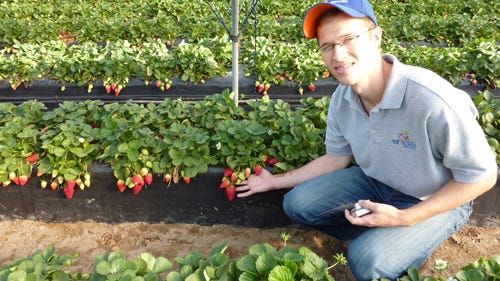
GAINESVILLE — As National Strawberry Day approaches Feb. 27, you can bite into a Florida strawberry, and you might taste the tang of the fruits bred through the combined efforts of University of Florida Institute of Food and Agricultural Sciences researchers.
Vance Whitaker, a UF/IFAS associate professor of horticultural sciences, continues his quest to breed the latest and greatest strawberry cultivar. But like all UF/IFAS scientists, Whitaker knows it takes a team to do that.
Among those who regularly help him, Whitaker credits Natalia Peres, a UF/IFAS associate professor of plant pathology, and Charles Sims, a professor of food science and human nutrition, with helping him breed better strawberries. Whitaker works with Peres to screen advanced breeding selections for disease resistance.
Sims conducts taste panels from his Gainesville lab, and the results give Whitaker tools to produce strawberries with the qualities consumers desire most — taste, smell and fruit appearance and texture.
Whitaker cross-pollinates the best genetic traits of various strawberries at the UF/IFAS Gulf Coast Research and Education Center in Balm. Peres also conducts her research at the Gulf Coast REC. Whitaker and his predecessors, most recently, Professor Emeritus Craig Chandler, have produced several successful cultivars.
Chandler produced Florida Radiance, which is grown on about 75 percent of Florida's strawberry acreage. Whitaker came up with the Sweet Sensation brand, which comprises about 15 percent of acreage.
Sweet Sensation is bigger and contains more sugar and aroma than Florida Radiance, an area consumers might notice, Whitaker said. It also has a juicy texture and long shelf life, which means the fruit stays at an acceptable quality for two to three days longer than Radiance while it's in cold storage. Additionally, Sweet Sensation is resistant to anthracnose, a disease that kills many strawberries.
Florida Radiance is more attractive in the container because of its deeper red color. It also tastes exceptionally good, Whitaker said. Growers also like Florida Radiance because it consistently produces steady yields of nicely-shaped fruit, and it tolerates rain and other poor weather conditions.
"They basically have some complementary strengths and weaknesses, and growers can try to take advantage of those for different markets and different times of the season," Whitaker said. "They are the same price, and the consumer will usually not know what variety is in the container. It's helpful for growers to be able to substitute either variety, depending on the supermarket chain, region they are shipping to, weather and other factors."
Over the past several decades, scientists at the Gulf Coast REC have bred several other strawberry varieties, including Winterstar, Florida Elyana, Winter Dawn, Rubygem, Carmine, Strawberry Festival, Earlibrite, Rosa Linda, Sweet Charlie, Florida Belle and Dover, and Florida Ninety.
Whitaker noted that, after a wet January, February may turn out to be a very good month for strawberry production.
"Up until the end of January, record heat and rainfall have reduced yields and quality," he said. "Many people have noticed that there aren't as many strawberries in the store. However, the cooler weather has been causing the quality to go up in February, so it should be a good month to buy Florida strawberries."
This article originally appeared on Crestview News Bulletin: How to distinguish Sweet Sensation from Florida Radiance strawberries
